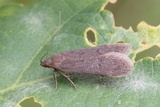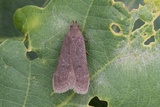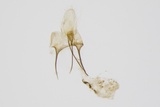Anacampsis timidella (Wocke, 1887) Species
Last modified: Jan. 25, 2025, 11:16 a.m.
First time observed in Belgium in 2016 in LX. Hitherto a very rare and local species in the southern part of our country.
Details
- Classification
- Family: Gelechiidae > Subfamily: Anacampsinae > Tribus: Anacampsini > Genus: Anacampsis > Species: Anacampsis timidella
- Vernacular names
- Eikenspikkelpalpmot (NL), Eichen-Palpenmotte (DE)
- First mention in Belgium
- Wullaert S. 2017b. Resultaten van de Werkgroep Bladmineerders uit 2016 met meldingen van minerende en andere zeldzame Lepidoptera in België en met 5 nieuwe soorten voor de Belgische fauna (Coleophoridae, Tortricidae, Gelechiidae en Nepticulidae). — Phegea 45(3): 79–96. On page 88. view page
- Status
-
Native
Distribution
Imago
Wingspan 14–17 mm. Eyes red. Head and thorax unicolorous brown, palp pale ochreous. Forewing variable brownish or dark greyish, slightly pale bluish tinged, more or less sprinkled with darker scales, stigmata dark brown, rather indistinct, discal stigma 2 most prominent (Gregersen & Karsholt 2022), a light postmedian fascia indicated, three to five indistinct spots near termen. Hindwings greyish brown.
Can be externally very similar to Anacampsis scintillella which is usually smaller, but not always separable without dissection of the genitalia.
Caterpillar
Abdomen reddish brown to blackish brown, head blackish brown to black, prothoracic plate black, large and bisected by a narrow structure, anal plate brown to blackish, pinacula blackish brown with strong setae.
Cocoon/pupa
The pupa is reddish brown with a short cremaster not clearly differentiated. Its sides are rather straight to slightly convex to the end.
Bionomics
The larvae live in a transversely rolled leaf on the host plant. Pupation takes place on the ground.
Adults are attracted to light.
Flight periods
The adults have been seen from early June towards late September.
Observed on
- Host plant (species):
- Quercus pubescens, Quercus robur and Quercus petraea
The monophagous larva lives on different species of Quercus.
Habitat
It occurs in warmer oak forests or oaks standing in xerothermic places.





